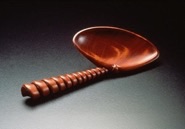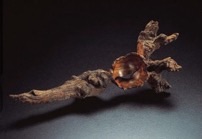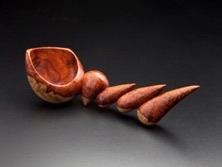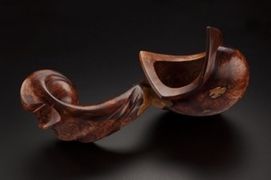|
Norm Sartorius
Norm Sartorius (born 1947) is an American woodworker who carves fine art spoons in many styles including natural, biomorphic, abstract, symbolic, ethnic, and ceremonial. His works are in the permanent collections of the Smithsonian American Art Museum's Renwick Gallery, the Yale University Art Gallery, the Philadelphia Museum of Art, and other public and private collections. He is a frequent participant in woodworking and craft shows in America, and won the Award of Excellence in Wood at the 2015 American Craft Council show in Baltimore[1] and the 2015 Smithsonian Craft Show in Washington, DC.[2] Since 2008, he has co-directed a grant-funded research project on the life, work, and legacy of American woodworker Emil Milan.[3] Early life and educationBorn in Salisbury, MD, Sartorius grew up on Maryland's Eastern Shore, the son of a country doctor.[4] In interviews, he said that the arts were not emphasized in his family,[5] but he was highly attuned to nature as a child.[6] He received his BA in Psychology from Western Maryland College (now McDaniel College) in 1969, then worked as a psychiatric social worker for five years at Spring Grove State Hospital in Catonsville, MD. He changed careers and completed an apprenticeship with crafters Phil and Sandye Jurus (Jurus Studio, Baltimore, MD), who had studied with Emil Milan.[7] There, he learned how to make small functional wooden items, including spoons.[8] Early careerIn the mid-1970s, he moved to rural West Virginia and started selling wooden works including cutting boards, pie servers, canes, knife racks, and spoons at regional craft fairs.[9] At Winterfair, an annual Ohio Designer Craftsmen show in Columbus, Ohio, he met studio furniture maker Bobby Reed Falwell, who encouraged him to focus on spoons and to see spoons as small sculptures.[10] He was an assistant for 18 months at Falwell's studio in Murray, KY in 1980-81. Early exhibitions of his fine art spoons included the West Virginia Craft Exhibit at the Union Carbide Gallery, New York City (1977) and an invitational exhibit of West Virginia craft at the Renwick Gallery of the Smithsonian's American Art Museum in Washington, DC (1979).[11] In 1978, a work of his was selected for the Fine Woodworking Design Book.[a] He was juried into the American Craft Council craft show in Baltimore for the first time 1979. In 1981, and again in 1989 and 1991, he received the Governor's Award of Excellence at the West Virginia Juried Exhibition, resulting in the works being purchased for the state's permanent craft collection.[12] The annual Mountain State Art and Craft Fair in Ripley, WV was particularly important as a proving ground for his maturing design style and craft business.[13] He met his future wife, glass artist Diane Bosley, at the annual Fair in 1981, moved to Parkersburg, WV in 1982, and they married in 1983. In 1986, his spoons were featured in an exhibit at the Pro-Art Gallery in St. Louis in conjunction with the Craft Alliance's high-level Wooden Vessels exhibit.[14] Other early exhibits included the Huntington Gallery (WV) traveling craft exhibit (1985–86); another exhibit at the Pro-Art Gallery entitled The Medium is Wood (1987); and the exhibit Contemporary Works in Wood at the Cultural Arts Center, Athens, Ohio (1986, 1989). The 1990 American Craft Council show in Atlanta has been cited as a major turning point for Sartorius' career.[15] He focused exclusively on high end spoons and redesigned his booth to create a gallery-like environment, presenting each spoon as a sculpture.[16] Artistic approach and influencesSartorius has stated that he sees the concept of "spoon" like any other craft category such as "bowl," "plate," or "teapot," in that each allows endless exploration of form, size, color, texture, symbolism, meaning, and emotional valence.[17] His works have been said to not only "explore the possibilities of what it means to be a spoon," but "play with deep-seated assumptions regarding a spoon's characteristics."[18] He has stated that, "Spoons are an infinite category. You can make thousands and no two are alike."[19] He credits James Krenov's book A Cabinetmakers' Notebook (1976)[20] with stimulating his sensitivity to the unique character of each piece of wood. He attributes his sculptural style that shuns embellishment in favor of pure line and form to Emil Milan, an American woodworker who trained as a sculptor.[21] Although Sartorius never met Milan, his first mentors, Phil and Sandye Jurus, studied with Milan and passed on key aspects of his approach and tool use. Sartorius' sculpture Homage now in the Yale University Art Gallery is a tribute to Milan.[22] Other acknowledged influences are Dona Meilach's books on small wooden works[23][24] and articles in the early volumes of Fine Woodworking magazine.[25] Sartorius has acknowledged several sources of inspiration. First, he has drawn on spoon-making traditions in diverse cultures ranging from Northwest Coast Native American horn spoons to carved spoons from West Africa.[26] In 1996, he obtained a grant to study and photograph spoons from around the world at the Smithsonian's repository in Suitland, MD.[27] Second, he stated in an interview that he "sees spoons" in everything, particularly in natural forms such as seedpods, leaves, flowers, and found and weathered objects.[28] It has been noted that the influence of seashells, crustaceans, shore birds and other sealife often show through in this work.[29] Third, he is inspired by the wood itself, particularly contrasting heartwood and sapwood colors, unusual grain, knots, textures, or weathering in a piece. Every piece he crafts, he has said, "starts with the wood itself."[30] He has estimated that the characteristics of the piece of wood itself suggest the size and shape of more than 75% of his finished pieces.[31] Overall, he has described his creative approach as intuitive in that he reacts to the virtues of each piece of wood rather than forcing his own design intentions.[32] "The wood is usually the inspiration for the first cuts," he has said, "And the shape of the piece has to do with the texture, grain, and figure of it..."[33] He has stated that he places his most interesting pieces of wood within sight of his workbench, often for months, to contemplate possible spoons may that lie within.[34] Once he sees the spoon a piece can become, he has said, he acts quickly on the idea because he feels his creative inspirations cannot be turned on and off at will, but must be recognized and acted upon.[35] Wood, tools, and work processSartorius prefers to work with very dense hardwood, especially root wood and burls with contrasting heartwood and sapwood colors, figured grain, and unique character from knots, deformities, damage, weathering, or other idiosyncrasies.[36] Frequently, he uses scraps or cutoffs sent to him by other woodworkers from around the world—often with an interesting background story.[37] He, in turn, sends his scraps to carvers and jewelers who work at even smaller scale. The provenance of his raw materials contributes significantly to both the making and the sale of his spoons. He follows the same sequence of steps when crafting his spoons.[b] First, he uses a bandsaw to roughly shape the overall form of the spoon. Then, an inflatable sanding drum with very coarse 24-grit sandpaper is used to remove saw marks, smooth out the facets of the cuts, and shape the convex curves of the exterior of the bowl. He determines the exterior shape first before working on the inside of the spoon bowl. "It fixes the outside form," he has said, "which is sculpturally what one sees first."[38] A die grinder (rotary tool) with a carbide cutter is then used to remove mass from the concave interior of the bowl. Small cutters are used to further shape the piece, particularly the transition between the bowl and the handle, which he sees as particularly critical.[39] The fine details of the spoon are made with a carving knife, then a die grinder with a ball-shaped burr is used to clean up and refine the interior of the spoon bowl. This is followed by hours of hand work, sanding, scraping, and polishing the work. Selected works
Shows and awardsFor the past 25 years, Sartorius has participated in several juried craft shows each year including the Smithsonian Craft Show; the American Craft Council Fairs (principally Baltimore and Atlanta); the Philadelphia Museum of Art Craft Show; the American Craft Exposition (Evanston, IL); the West Palm Beach Craft Show; and Craft Boston, among others. He has won the Award of Excellence for wood at the Smithsonian Craft Show four times, most recently in 2015. He won the Collectors of Wood Art Award for Excellence at the American Craft Council Baltimore show in February 2015. He has also won the Best of Show award and the Wharton Esherick Award at the Philadelphia Museum of Art Craft Show; and Best In Wood awards at both the Washington Craft Expo and the American Craft Exposition in Evanston, Illinois. In 2014, he was awarded a Fellowship by the Tamarack Artisan Foundation for lifetime achievement in the arts. ExhibitionsBeyond Boundaries (2014)
Nature in Craft (2013)
Across the Grain (2013)
Poplar Culture (2012)
What is Beautiful?(2012)
Is Ornament a Crime? (2010)
A Revolution in Wood (2010)
A Gathering of Spoons (2010)
DysFUNctional (2008-2011)
Yale Collects Wood (2002)
Wood--Small Treasures (2000-2002, 2004, 2006-2007, 2009)
Woodturning in North America Since 1930 (2001-2002)
Objects for Use: Handmade by Design (2001-2002)
Living With Form (2000)
Art in Embassies Program (1998-2001)
Expressions in Wood (1997-98)
West Virginia Juried Exhibition (1995–96, 1999-2000, 2005, 2007, 2008)
Challenge V, Lathe-Turned Objects, (1994–97)
The Year of American Craft (1993–94)
Major works
Permanent collectionsWorks by Sartorius are in permanent collections of many museums including the Arkansas Arts Center; the Carnegie Museum of Art (PA); the Center for Art in Wood (PA); the Fuller Craft Museum (MA); the Minneapolis Institute of Arts; the Museum of Art and Design (NY); the Museum of Fine Arts, Houston (TX); the Philadelphia Museum of Art; the Racine Art Museum (WI); the Smithsonian American Art Museum's Renwick Gallery (DC); and the Yale University Art Gallery (CT). The Emil Milan research projectSince 2008, Sartorius has collaborated with woodworkers Phil Jurus and Barry Gordon on a research project focused on the life, work, and legacy of American master craftsman Emil Milan. Funded by a grant from the Center for Craft, Creativity, and Design, the Emil Milan Research Project[46] has resulted in an article in Woodwork magazine[47] and a research report containing extensive biographical and archival material.[c] Sartorius played a major role in curating the exhibit entitled Emil Milan: Midcentury Designer Craftsman held at the Henry Gallery on the campus of Penn State Great Valley in Malvern, PA June 9 – September 26, 2014.[48] The exhibit, which included works by Sartorius, traveled to the Center for Art in Wood in Philadelphia and was expanded to include 19 artists influenced by Milan. The exhibit, entitled Rediscovering Emil Milan and his Circle of Influence, was held at the Center November 7, 2014 – January 24, 2015. Sartorius was a speaker and panelist at a symposium held in conjunction with the exhibit focusing on Milan’s life, work, and influence.[d] Notes
References
|
||||||||||||||||||||||










